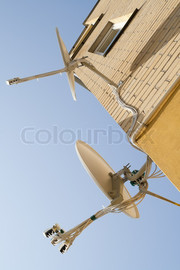Introduction

The Satellite dish we use in our homes is designed to receive what are referred to as “microwaves” from communications satellites. A satellite dish is a dish-shaped object on which a parabolic antenna is mounted. This antennae transmits data broadcasts, which has resulted in the now commonly used term: satellite television. Satellite dishes were once very expensive, large and difficult to install at one’s house, but recently the market has seen several sleek, compact dishes on top of every other house.
History

But where did it all begin? Critics argue that the man who planted the seed for satellites and satellite transmission was one Arthur C. Clarke who in his article Extraterrestrial Relays, published in “Wireless World Magazine” wrote that if you put three platforms to orbit in space at 22,300 miles at specific locations around the equator would enable worldwide communication. The Russians were the first to test the idea in 1957. Their “Sputnik” was followed by the USA’s “Explorer1” in early 1958. And with their success came celebrations, excitement and of course, there came a question: What more could be done? Several private companies answered the question by forming an international association in order to put up a system of geosynchronous satellites in space to orbit. But this process, some argue, was actually started in 1976, when HBO started delivering programming to cable via satellites. Around that time, a professor at Stanford University, E. H. T. Howard developed a huge dish-shaped antenna that was employed to catch cable TV programs that were broadcasted to cable subscribers. As former NASA scientist, he published a DIY manual and, with Bob Taggart, founded the company Chaparral Communications produced the hardware required. Six years later, Chaparral was worth $50 million and going strong. And the dish he created continued to evolve and change until it took the shape of the dishes that grace almost each house today.
Features

So how does it work? The curved satellite dish on your house reflects the signal to the “feedhorn” in the centre, that gathers the signals and transmits them to an LNB (low-noise block down converter). This in turn changes them to electrical signals and transfers these signals to what is called the L-band range. While the dishes have evolved and can be now attached to and used from vehicles, the most frequently used are the ones designed for homes. These are normally 43 cm/18 inches to 80 cm/31 inches in diameter. They’re fixed in one position, for Ku-band reception from the respective orbital position. There are several types of Satellite dishes, including the Motor-driven kind, the Multi-satellite kind, VSAT and several others, though the three mentioned are the ones used most commonly.
Tips and comments
One thing users frequently complain about is the hassle of installation of satellite on their house. Even the newer, smaller versions have proven a bit tricky to operate even if they’re easier to set up. We advise to thoroughly check the model and ensure the warranty period before purchase to avoid problems using a house satellite dish.